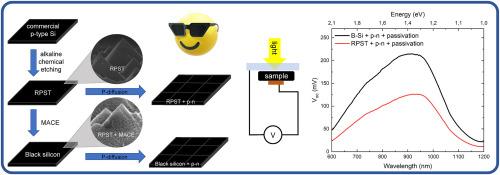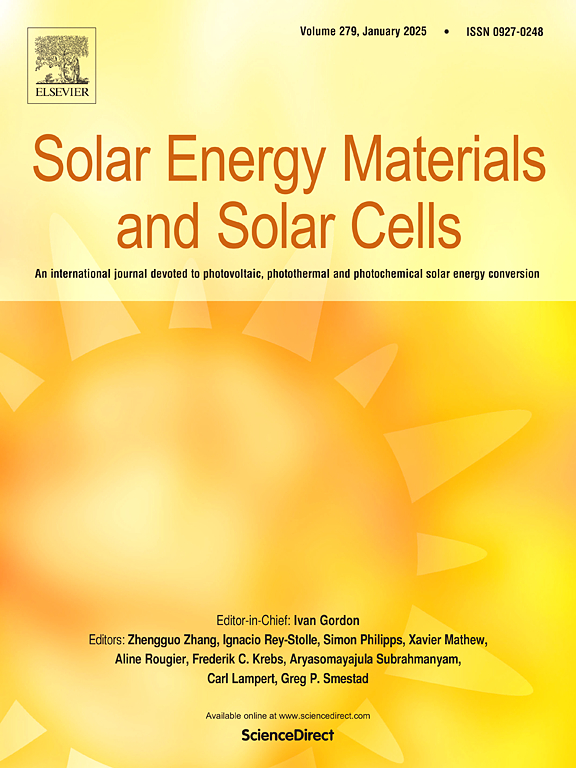表面光电压谱用于黑硅太阳能电池织构和钝化过程监测
IF 6.3
2区 材料科学
Q2 ENERGY & FUELS
引用次数: 0
摘要
本文讨论了利用表面光电压光谱(SPS)作为一种监测技术来优化黑硅(B-Si)基太阳能电池的制造工艺。介绍了SPV在黑硅基太阳能电池中不同表面微纳纹理化和钝化方案的研究结果。它显示了SPV信号如何对不同的程序敏感,如传统的碱性化学蚀刻和随后的处理以获得B-Si。因此,研究了不同金属(Ag和Cu)作为催化剂(金属辅助化学蚀刻)在纳米织构加工过程中,以及在氨气氛钝化退火过程中不同等离子体压力对SPV信号的影响。发现钝化后SPV信号的大小表明了无需金属触点沉积的太阳能电池的最终性能。SPV测量结果与商用寿命测试仪测量的少数载流子寿命和开尔文探针力显微镜(KPFM)测量的结果具有相关性。所提出的结果表明,如何SPV可以用于质量控制的目的,在太阳能电池制造的任何阶段。本文章由计算机程序翻译,如有差异,请以英文原文为准。

Surface photovoltage spectroscopy for texture and passivation processes monitoring in black silicon solar cells
This paper deals with the use of Surface Photovoltage Spectroscopy (SPS) as a monitoring technique to optimize the manufacturing process of black silicon (B-Si) based solar cells. The results of the application of the SPV to study different texturization (surface micro/nano texturing) and passivation schemes in black silicon-based solar cells are presented. It is shown how the SPV signal is sensitive to different procedures such as conventional alkaline chemical etching and a subsequent treatment to obtain B-Si. So, the effect on the SPV signal of the use of different metals (Ag and Cu) as catalyst in the nanotexturing processing (by Metal-Assisted Chemical Etching), as well as different plasma pressures during the passivating annealing in ammonia atmosphere were explored. The magnitude of the SPV signal after passivation was found to be indicative of the final performance of the solar cell without the need of metal contacts deposition. Result obtained by SPV measurements were correlated with the lifetimes of minority carrier measured using a commercial lifetime tester and with those obtained by Kelvin Probe Force Microscopy (KPFM). The presented results indicate how SPV can be used for quality control purposes at any stage of solar cell fabrication.
求助全文
通过发布文献求助,成功后即可免费获取论文全文。
去求助
来源期刊

Solar Energy Materials and Solar Cells
工程技术-材料科学:综合
CiteScore
12.60
自引率
11.60%
发文量
513
审稿时长
47 days
期刊介绍:
Solar Energy Materials & Solar Cells is intended as a vehicle for the dissemination of research results on materials science and technology related to photovoltaic, photothermal and photoelectrochemical solar energy conversion. Materials science is taken in the broadest possible sense and encompasses physics, chemistry, optics, materials fabrication and analysis for all types of materials.
 求助内容:
求助内容: 应助结果提醒方式:
应助结果提醒方式:


